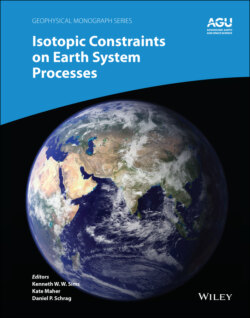Читать книгу Isotopic Constraints on Earth System Processes - Группа авторов - Страница 51
2.2.4. K Isotopic Measurements
ОглавлениеPotassium was separated for isotopic analysis from the sample solutions after Ca separation using columns loaded with 1.8 ml of AG30x8 cation resin. Sample aliquots with ∼600 ng K were dried down, taken up in 300 μL of 1 M HNO3, loaded on the columns, eluted with 1 M HNO3, and the K fraction was collected (Bourg et al., 2010). After drying the separated K solutions down, the K residue was brought up in 0.3 N HNO3 to a concentration of 400 ppb. The 41K/39K ratios of the separated K were measured using a multi‐collector ICP sourced mass spectrometer (IsoProbe, GV Instruments Ltd.) at Lawrence Berkeley National Lab. The IsoProbe is equipped with a RF hexapole ion‐guide that allows the introduction of gasses to provide both energy focusing as well the removal of isobaric interferences arising from Ar ions. In the case of the K isotopic measurements reported here, He and H2 were introduced to the hexapole region at rates of 10 mL/min and 1 mL/min, respectively, to suppress mass interferences from Ar isotopes. For K isotopic measurements, a standard‐sample bracketing technique was employed using an in‐house K reference (K spectroscopic standard, ULTRA Scientific) matching the sample unknowns in concentration (Christensen et al., 2018). The potassium isotopic composition is reported as:
Table 2.2 Summary of isotopic results.
| Sample | Distance (mm) | δ 44Ca | n | δ 41K | n |
|---|---|---|---|---|---|
| RP2–1 | 0.33 | 0.70 | 2 | – | – |
| RP2–2 | 0.99 | 0.46 | 5 | – | – |
| RP2–3 | 1.65 | 0.15 | 4 | – | – |
| RP2–4 | 2.31 | –0.37 | 2 | – | – |
| RP2–5 | 2.97 | –0.77 | 2 | – | – |
| RP2–6 | 3.62 | –0.90 | 2 | – | – |
| RP2–7 | 4.28 | –1.26 | 2 | – | – |
| RP2–8 | 4.94 | –0.78 | 2 | – | – |
| RP2–9 | 5.60 | –0.78 | 2 | – | – |
| RP2–10 | 6.26 | – | – | – | – |
| RP3–1 | 0.33 | –0.42 | 3 | –2.35 | – |
| RP3–2 | 0.98 | –0.62 | 3 | –3.47 | – |
| RP3–3 | 1.63 | 0.01 | 2 | –4.19 | – |
| RP3–4 | 2.28 | 0.95 | 2 | –2.44 | – |
| RP3–5 | 2.93 | 0.68 | 2 | –1.2 | – |
| RP3–6 | 3.59 | –0.68 | 2 | 0.54 | – |
| RP3–7 | 4.24 | –0.78 | 2 | 1.01 | – |
| RP3–8 | 4.89 | –0.91 | 2 | 1.38 | – |
| RP3–9 | 5.54 | –0.76 | 2 | 1.59 | – |
| RP3–10 | 6.19 | – | – | – | – |
| Rhyolite | – | –0.29 | 3 | – | – |
| Phonolite | – | –0.36 | 4 | – | – |
(2.2)
where (41K/39K)reference is the average of the two bracketing analyses of the K reference solution prior to and after the analysis of the sample. The sample solutions were introduced to the IsoProbe using using an Aridus II (Cetac Technologies) desolvation system with a Teflon nebulizer with a measured uptake of 60 microlitres/minute. Approximately 150 ng of K was used per isotopic analysis run. The typical uncertainty in δ 41K is conservatively given as ± 0.3‰ and is based on the combined uncertainties in the measured 41K/39K of the bracketing reference and samples. Further details on the mass spectrometry technique can be found in Richter et al. (2011).
